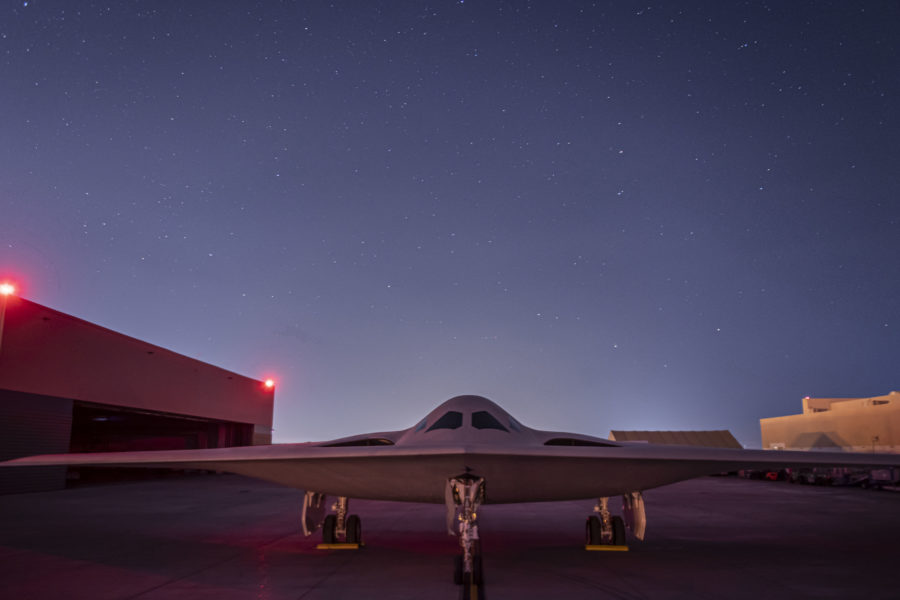Despite Australia’s recent revelation that it discussed buying B-21 bombers from the U.S.—and decided against it—Northrop Grumman said such a move may still be “on the table.”
Australia’s just-released Defense Strategic Review stated that the defense ministry “has undertaken detailed discussions in Australia and the United States in relation to the B-21 Raider as a potential capability option for Australia,” although it didn’t disclose when these discussions took place.
“In light of our strategic circumstances and the approach to defense strategy and capability development outlined in this review, we do not consider the B-21 to be a suitable option for consideration for acquisition,” the report said.
However, Northrop Grumman chief executive officer and president Kathy Warden said the door may still be open to such an arrangement.
“It would be premature for us to be working with another government” on the B-21, given its current developmental status, Warden said in an April 27 earnings call.
“I think it’s important that there were discussions—ongoing ones,” about a B-21 sale or collaboration, she said, noting that this would have surprised her a few years ago.
Discussions and ties between Australia and the U.S. have ramped up over the past few years. In particular, the AUKUS agreement—which includes the United Kingdom—began with the goal of sharing nuclear-powered submarine technology but has expanded to other areas as well.
AUKUS “is going to change how those nations … work together more collaboratively, and I wouldn’t take it off the table in the long run, as other strategic capabilities become part of that dialog,” Warden said.
Given “where the B-21 is today, I think it appropriate that they did not count on it in their Defense Strategic Review,” Warden added.
Mark Gunzinger, director of future concepts and capability assessments at the Mitchell Institute for Aerospace Studies, said the Australian review’s B-21 conclusion “was disappointing, but then there is plenty of time to revisit this in the future.” He added that Warden “is right, the Air Force hasn’t even accepted its first aircraft yet,” but said he did not believe “the books are closed on the option.”
In a statement, Secretary of Defense Lloyd J. Austin III did not address the B-21 decision in the strategic review, specifically, but he hailed “Australia’s commitment to being at the forefront of incorporating new capabilities” for its military.
“It is the latest example of the pivotal role Australia plays in preserving a free and open Indo-Pacific, including through participation in AUKUS and the Quad,” Austin said, noting that Australia is also planning to release its first ever National Defense Strategy in 2024.
While Australia won’t be pursuing the B-21 right now, Warden said Australia in February made a Foreign Military Sales request for more than $500 million worth of Northrop’s AARGM-ER (Advanced Anti-Radar Guided Missile, Extended Range), “a high-speed, long-range air-to-ground missile that provides counter air defense capability.” Australia is also pursuing long-range strike by buying Lockheed Martin’s Long-Range Anti-Shipping Missile, or LRASM; a complement to its inventory of the similar Joint Air-to-Surface Standoff Missile (JASSM-ER).
Still Waiting on First Flight
While Warden addressed Australia’s interest in the B-21, she offered no new details on the aircraft’s progress, only saying it is expected to fly “this year,” and that the company expects the first low-rate initial production contract award by the end of the year.
At the B-21’s rollout in December 2022, Air Force and program officials hinted that they expected the bomber’s first flight to take place in the middle of 2023, after several months of outside engine runs and taxi tests.
But an Air Force spokeswoman said the service has not officially pegged “mid year” as the target date.
“We’ve been saying ‘in 2023,’” the spokeswoman said.
The first flight of the B-2 bomber followed its rollout by nine months, and USAF officials have said privately they expected the B-21 to beat that.
There have been several slips to the B-21’s expected first flight. Former Vice Chief of Staff Gen. Seve Wilson said in 2019 he expected first flight in 2021; former B-21 program executive officer and head of the Rapid Capabilities Office Randall Walden predicted in late 2021 that first flight would occur “mid-2022.” That later gave way to the service announcing the rollout would take place “by the end” of 2022.
Warden said the B-21 program, like Northrop’s other aeronautics projects, has been affected by labor cost increases and inflation, and while inflation may moderate, labor costs, once elevated, don’t tend to come down. On a January earnings call, she suggested these conditions would affect profitability on the first five aircraft, which are being built under a fixed-price contract.
On the April call, Warden said the inflation estimates used in 2015, when Northrop successfully bid for the B-21, were running about two percent, and the company made its offer based on the Federal Reserve’s successful efforts at managing inflation close to that figure.
She said Northrop is working with the government on getting some relief from those fixed-price limits, using legislatively-approved methods for helping contractors who’ve taken big program hits due to high inflation, but no agreements have been reached.
In addition to inflation, Warden said Northrop is working with the government on expanding production of munitions, a high priority in recent months.
In particular, Northrop has expanded a facility at the Alleghany Ballistic Laboratory in W.V., which Warden called a “factory of the future,” which will support the production of up to 600 strike missiles per year, including AARGM-ER, GMLRS, TOW, Hellfire, and Precision Strike Missile. The company is also opening a hypersonics design and development laboratory and production facility in Elkton, Md. this summer, Warden said, where it will work on the engine for the Raytheon-led Hypersonic Attack Cruise Missile (HACM) program and other programs.


